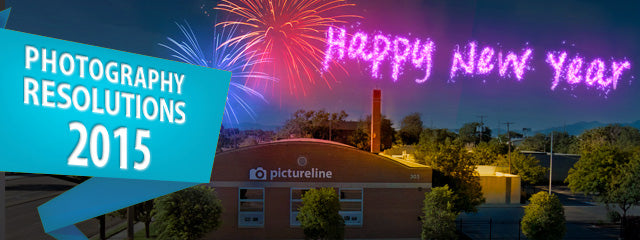If you're anything like the millions of people that make a list of resolutions in honor of the new year, then you're probably also familiar with buying a gym membership, faithfully working out everyday for a week and quickly losing motivation all together. We all know the feeling, so why don't you give yourself the opportunity to set a New Year's goal you can accomplish and enjoy as well?
Have you ever wanted to improve your photography skills but never found the right time or motivation to start? With New Year's just around the corner, now is the best time to finally get yourself in gear to take that photography class, or purchase that editing software you've always wanted. If you want to take your photography from beginner to pro, here's the pictureline list of resolutions to help get you on your way!
#1. Learn to Shoot in Manual
The prospect of shooting in manual mode can be a little scary, which is why you've probably stayed in automatic all this time. Trust me on this though, you're doing more harm than good! You're limiting yourself as an artist and your photography is hurting because of it. By learning to shoot in manual mode, you have the ability to fully control the camera and this is where the true improvement begins. Shooting in manual requires an understanding of ISO, Aperture, Shutter Speed and White Balance but once you've learned how to make all these settings dance together correctly, the results are incredible. The best advice to learn these settings would be to...
#2. Take a Photography Class
When you first bought your camera, you probably kept telling yourself, "one day I'll take photography classes," but you just never got around to it and as a result you own an incredibly expensive DSLR that sits in auto. It's comparable to having the highest-quality Gamblin Oil Paints in hopes of one day creating a masterpiece and you're still using crayons. It's insulting to the camera. You could always pick up a book, or watch YouTube tutorials when it comes to camera settings, but photography is best understood by hands-on learning. Having an expert personally show you how the camera works and to then have the opportunity to practice the technique is the quickest way to improve your photography skills! But where do I find photography classes, you may ask? Lucky you, we offer them here at pictureline!

#3. Start Shooting in RAW
So you've probably heard this term before, but have no idea what it means. I'm not talking about raw chicken, or raw cookie dough (thought the latter sounds delicious). RAW is a file format that captures all recorded data from the sensor, as opposed to JPEG format which compresses the information and therefore data is lost. By shooting in RAW, you are capturing the highest level of image quality and have the ability to later correct problems in the image that is otherwise lost in JPEG. Post-processing allows you to correct over/under exposed areas, adjust white balance and reduce lens distortion all of which wouldn't be an option in JPEG. Keep in mind, you do need special software to view these files, and they do take up much more space in your camera and hard-drive, but the trade-offs are worth it when your image quality drastically improves.
#4. Invest in Editing Software
The best advice I could give beginner photographers interested in honing their skill and improving image quality would be to stop using free editing programs. It's not because the programs are cheap and easily accessible, but because any potential your images had was lost when you applied that hideous filter to it. Programs like Photoshop and Lightroom are excellent choices, and both have their strengths and weaknesses. If simple image management, RAW processing, clean workflow and easy presets are what you're looking for, Lightroom is the way to go - and did I mention how affordable it is? But if an in-depth editing system is on your mind, Photoshop is gold. Retouching, blending, compositing and layer stitching are among the few incredible features accessible in Photoshop, though using the program is a little pricey and requires a bit of education - here's your chance to go take that class!
#5. Compose your Shot
In photography, it's not what you photograph, but how you photograph it. Composing a shot is all about telling a story; you want to lead your viewer on a journey through the image to inflict an array of emotions, and simply by the way you frame the subject or situation can make or break your image. Develop an understanding for aspect ratios, leading lines, shapes and colors so you can incorporate them into your story. Once you've gained enough knowledge of these rules, you can then learn to break them. Just because there is an incredible image incorporating the rule of thirds, there is an equally incredible image that breaks the rule. Photography is a long process, and you're not meant to learn it all over night, but you are meant to enjoy it!
 Fibonacci Spiral or Golden Spiral
Fibonacci Spiral or Golden Spiral
